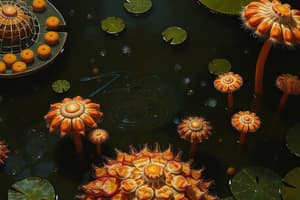Podcast
Questions and Answers
What is a defining characteristic of Protists?
What is a defining characteristic of Protists?
- Presence of chloroplasts
- Multicellularity
- Aquatic habitat
- Eukaryotic nature (correct)
Which organelles can a Protist possess?
Which organelles can a Protist possess?
- Ribosomes and endoplasmic reticulum
- Cell wall and central vacuole
- Chloroplasts and mitochondria (correct)
- Golgi apparatus and lysosomes
What is the kingdom Protista best described as?
What is the kingdom Protista best described as?
- Unicellular and prokaryotic
- Multicellular and prokaryotic
- Unicellular and eukaryotic (correct)
- Multicellular and eukaryotic
Which of the following is an example of multicellular Protists?
Which of the following is an example of multicellular Protists?
What distinguishes Protists from plants, animals, and fungi?
What distinguishes Protists from plants, animals, and fungi?
What distinguishes protists from prokaryotes?
What distinguishes protists from prokaryotes?
What is a characteristic of ciliates among protozoans?
What is a characteristic of ciliates among protozoans?
Which protist is recognized by its spherical shape and use of pseudopods to capture prey?
Which protist is recognized by its spherical shape and use of pseudopods to capture prey?
What distinguishes diatoms among single-celled algae?
What distinguishes diatoms among single-celled algae?
What is a characteristic of algae found in the kingdom Protista?
What is a characteristic of algae found in the kingdom Protista?
Flashcards are hidden until you start studying
Study Notes
Protists: Eukaryotic Microorganisms
- Protists are eukaryotic microorganisms with cells containing a nucleus and membrane-bound organelles like chloroplasts and mitochondria.
- Living organisms are classified as eukaryotes (with a nucleus) or prokaryotes (without a nucleus).
- Prokaryotes, such as bacteria and cyanobacteria, lack a membrane-bound nucleus or other organelles.
- Protozoans, a type of protist, are single-celled, animal-like microorganisms found in freshwater or saltwater.
- Protozoans are heterotrophic, free-moving, and can be parasitic, consuming other organisms for energy.
- Ciliates, a group of protozoans, have cilia to hunt for prey, move quickly through water, feed, attach to other organisms, and feel sensations.
- Flagellates, another type of protozoan, have flagella and can be plant-like (autotrophs) or animal-like (heterotrophs).
- Heliozoans are freshwater, unicellular protozoans recognized by their spherical shape and silica shell, using pseudopods to capture prey.
- Amoebas are eukaryotic, single-celled protozoa that can alter their cell shape, forming pseudopods to move and capture prey through phagocytosis.
- Algae, found in the kingdom Protista, range from unicellular to giant kelp and are typically autotrophs using photosynthesis for energy.
- Euglenophytes are unicellular organisms using flagella to move, being mixotrophs that can capture energy from the sun or ingest prey.
- Diatoms, single-celled algae with a glass-like silica shell, form the base of the food chain in aquatic environments and are autotrophs using chloroplasts for energy.
Studying That Suits You
Use AI to generate personalized quizzes and flashcards to suit your learning preferences.




